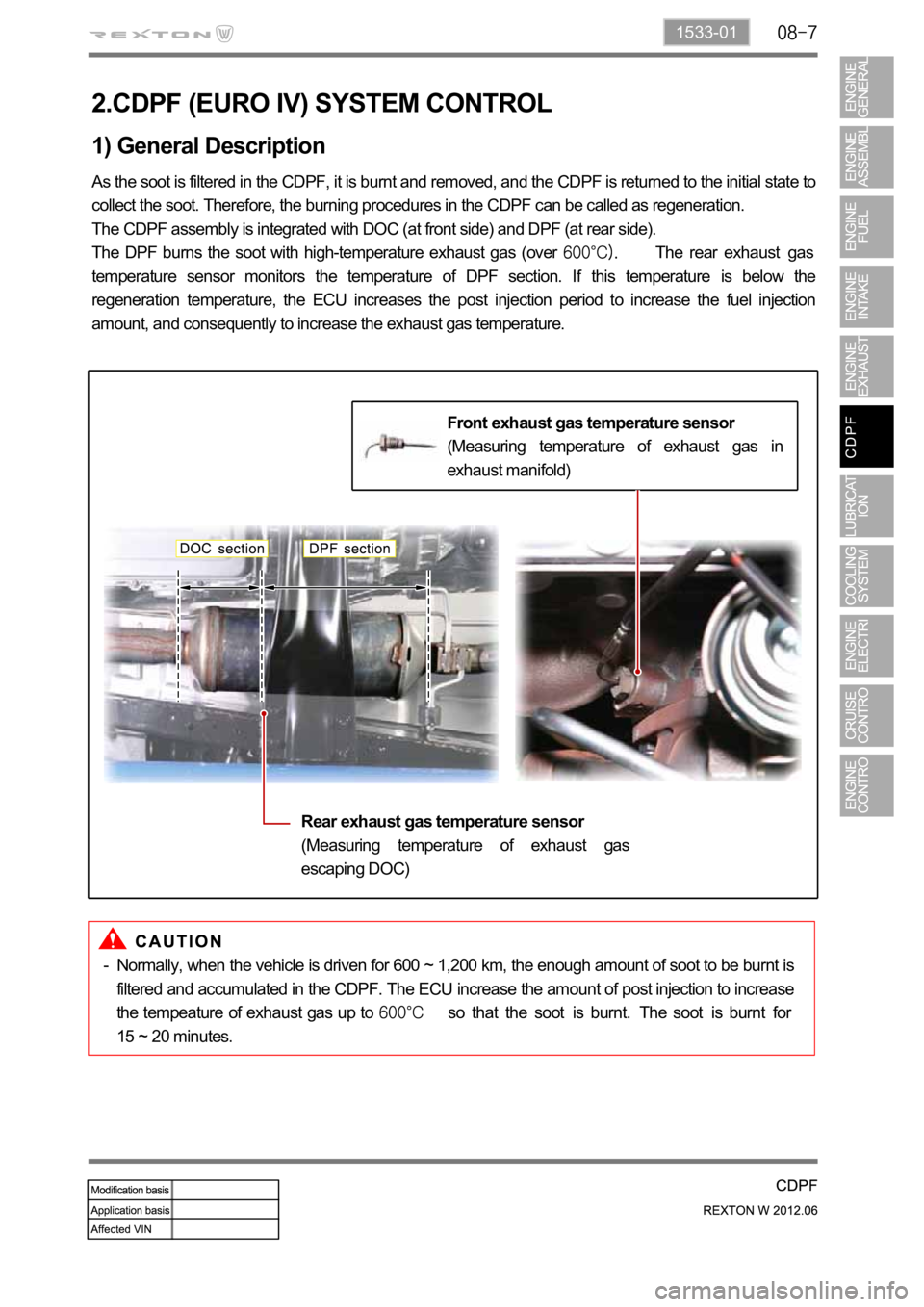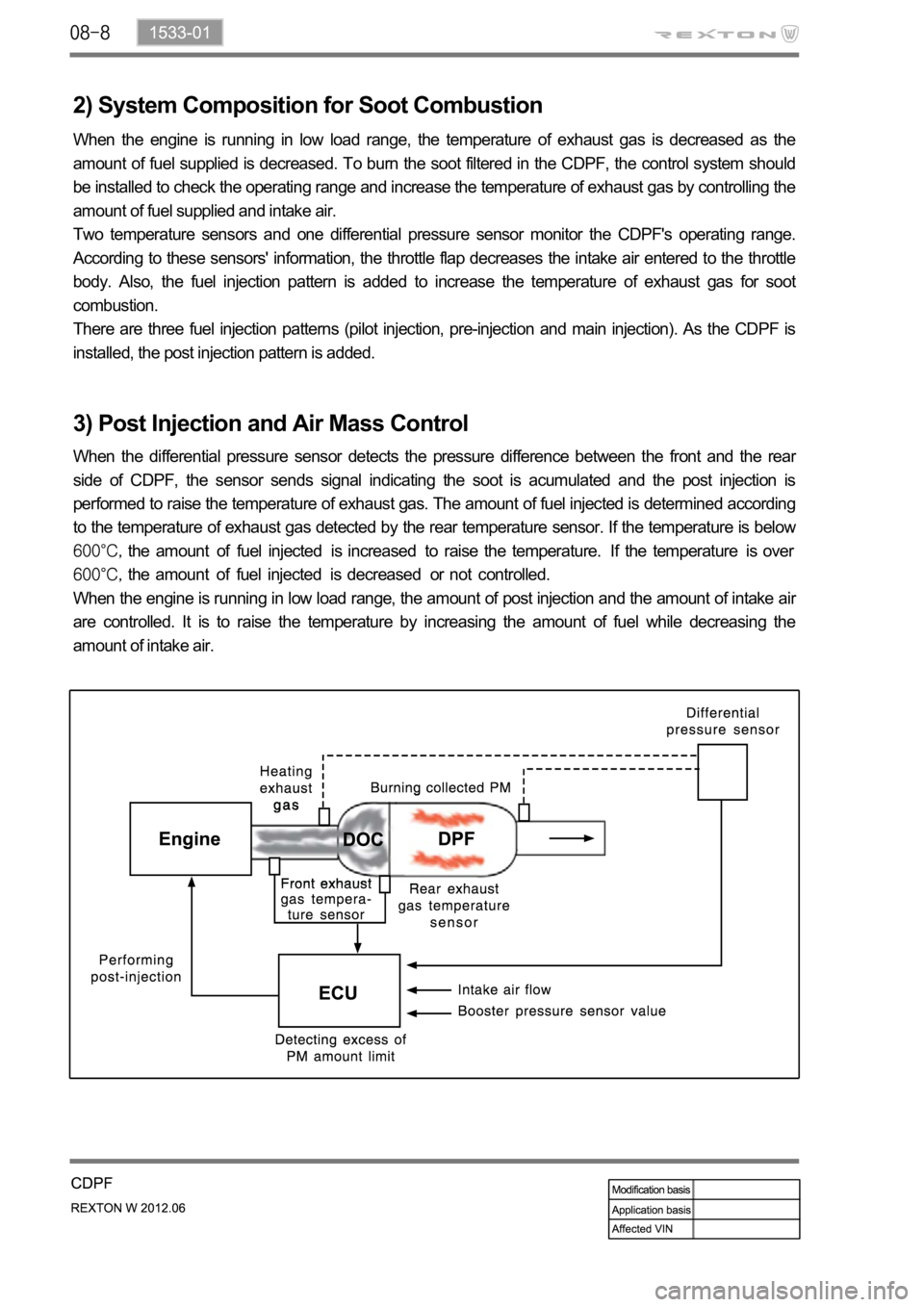Page 214 of 600
3. HYDRAULIC CYCLE IN FUEL LINE
(TRANSFER AND HIGH PRESSURE LINE)
Page 223 of 600

1533-01
Throttle Body
CDPF system controls the amount of intake air by controlling the
electronic throttle body. The electronic throttle body has the
following main functions.
CDPF control - added a function that increases the exhaust gas
temperature by closing the throttle valve flap to minimize the intake
air amount by the fuel injection amount during the CDPF
regeneration range with the low engine load range.
ON/OFF control - prevents the engine from turning off with
vibration and noise by closing the throttle body flap to block the
intake air when the engine is stopped.
Duty control - controls the valve inside the throttle body to burn
more EGR gas in the EGR valve operating range.
VGT Turbocharger and Front Exhaust Gas Temperature Sensor
Turbocharger may become weaker if high tem-
perature exhaust gas passes through the tur-
bocharger for DPF regeneration process.
The front exhaust gas temperature sensor moni-tors
the temperature of the exhaust gas that flows into the
turbocharger.
If the temperature of the exhaust gas that passes
through the exhaust manifold is higher than the
specification, the ECU decreases the fuel injection
amount and increases the EGR gas intake amount to
decrease the exhaust gas temperature.Front exhaust gas
temperature sensor
Page 225 of 600

1533-01
2.CDPF (EURO IV) SYSTEM CONTROL
1) General Description
As the soot is filtered in the CDPF, it is burnt and removed, and the CDPF is returned to the initial state to
collect the soot. Therefore, the burning procedures in the CDPF can be called as regeneration.
The CDPF assembly is integrated with DOC (at front side) and DPF (at rear side).
The DPF burns the soot with high-temperature exhaust gas (over
The rear exhaust gas
temperature sensor monitors the temperature of DPF section. If this temperature is below the
regeneration temperature, the ECU increases the post injection period to increase the fuel injection
amount, and consequently to increase the exhaust gas temperature.
Front exhaust gas temperature sensor
(Measuring temperature of exhaust gas in
exhaust manifold)
Rear exhaust gas temperature sensor
(Measuring temperature of exhaust gas
escaping DOC)
Normally, when the vehicle is driven for 600 ~ 1,200 km, the enough amount of soot to be burnt is
filtered and accumulated in the CDPF. The ECU increase the amount of post injection to increase
the tempeature of exhaust gas up to
so that the soot is burnt. The soot is burnt for
15 ~ 20 minutes. -
Page 226 of 600

2) System Composition for Soot Combustion
When the engine is running in low load range, the temperature of exhaust gas is decreased as the
amount of fuel supplied is decreased. To burn the soot filtered in the CDPF, the control system should
be installed to check the operating range and increase the temperature of exhaust gas by controlling the
amount of fuel supplied and intake air.
Two temperature sensors and one differential pressure sensor monitor the CDPF's operating range.
According to these sensors' information, the throttle flap decreases the intake air entered to the throttle
body. Also, the fuel injection pattern is added to increase the temperature of exhaust gas for soot
combustion.
There are three fuel injection patterns (pilot injection, pre-injection and main injection). As the CDPF is
installed, the post injection pattern is added.
3) Post Injection and Air Mass Control
When the differential pressure sensor detects the pressure difference between the front and the rear
side of CDPF, the sensor sends signal indicating the soot is acumulated and the post injection is
performed to raise the temperature of exhaust gas. The amount of fuel injected is determined according
to the temperature of exhaust gas detected by the rear temperature sensor. If the temperature is below
the amount of fuel injected is increased to raise the temperature. If the temperature is over
the amount of fuel injected is decreased or not controlled.
When the engine is running in low load range, the amount of post injection and the amount of intake ai
r
are controlled. It is to raise the temperature by increasing the amount of fuel while decreasing the
amount of intake air.
Page 227 of 600
1533-01
Throttle bodies by engine type
The throttle valve is controlled by electric signals sent from the engine ECU for optimal fuel
injection volume, engine load and effective combustion of EGR gas according to the Euro 4
regulations. It has following functions by the engine type. -
Page 230 of 600
2) Fuel Injection During CDPF Regeneration
3) Warning Lamp Related To CDPF
CDPF regeneration process (warning lamp NOT illuminated)
The CDPF system enters the regeneration mode when the
driving distance becomes approx. 600 to 1,200 km (may
differ by the driving condition and driving style). Then, the
engine ECU performs the CDPF regeneration operation.
However, the driver is not in-formed with this operation by an
y
engine warning lamp or vehicle signal, so he/she may not
detect this operation. The control logic at the post-injection
dur-ing the regeneration process is to increase the fuel
injection volume and control the intake air volume (by the
throttle body) in order to increase the tem-perature of the
exhaust gas. The driver may not feel any particular difference
from the vehicle.
No illumination
Page 258 of 600
2. MAJOR COMPONENTS
Front view
Vacuum pump
Camshaft position sensor
Oil filter assembly
Power steering pump pulley
Oil pressure switch
Idler pulley No. 2
Water pump pulley
Alternator pulley
Auto tensioner
Idler pulley No. 1
A/C compressor pulley
Rear view
E-EGR valve
Fuel temperature sensor
Fuel HP pump assembly
Coolant temperature sensor
IMV valve Crankshaft position sensor
Isolation damper
Page 261 of 600
0000-00
1) Service Interval
DescriptionDaily
inspectionWeekly
inspectionService interval
Engine oil & oil
filterInspection - EU Change every 20,000 km or 12 months
(The service interval should be
shortened under severe conditions)
General Change every 15,000 km or 12 months
(The service interval should be
shortened under severe conditions)
Coolant Inspection - Change every 200,000 km or 5 years
Air cleaner
element- Inspection Diesel EU Change every 20,000 km
(The service interval should
be shortened under severe
conditions)
General Clean every 7,500 km,
change every 15,000 km
(The service interval should
be shortened under severe
conditions)
Gasoline Clean every 15,000 km, replace every
60,000 km (The service interval should
be shortened under severe conditions)
Fuel filter - - EU Change every 40,000 km (Draining
water from fuel filter: whenever replacing
the engine oil)
General Change every 45,000 km (Draining
water from fuel filter: whenever replacing
the engine oil)